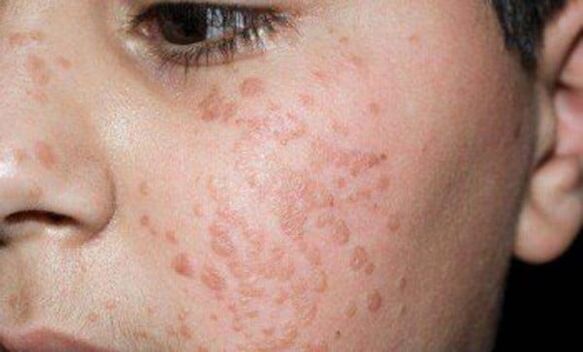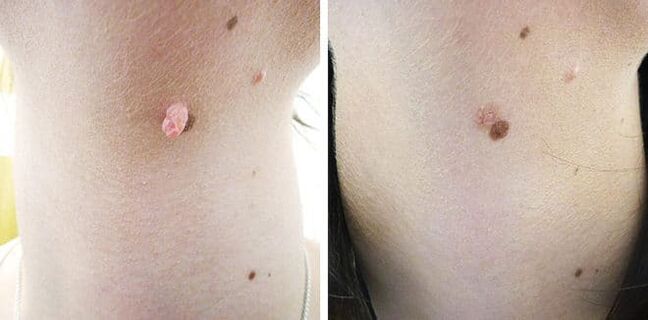Papillomas and condylomas are small skin tumors of a viral nature. You need to be able to distinguish between them in order to promptly recognize potentially dangerous formations and take the necessary measures. The main thing that distinguishes papillomas from papillomas is the type of virus that causes the disease.
Causes of cancer
The human papillomavirus (HPV) has more than a hundred different strains. HPV enters the body through indoor contact or through unprotected intercourse. The baby can be infected from the mother during birth.
The formation of growths indicates rapid division of cells in the basal layer of the skin. This occurs under the influence of a virus, the activation of which in most cases is associated with a decrease in immune defenses. Depending on the strain, papillomas or papillomas appear on the body.
Characteristic features of papillomas
Papilloma is a benign tumor, causing no discomfort, except for aesthetics. Characteristic features of papillomas:
- soft homogeneous structure;
- the presence of a leg;
- small size (diameter up to 10 mm);
- moderate pigmentation.
Papillomas are localized on any part of the body, except for the mucous membranes of the genitals. As a rule, the color of the growth changes from the natural skin color to pinkish-red, however, highly pigmented papillomas are also not a pathology. The growth of body hair of papillomas is a variation of the norm.

Papillomas are not dangerous as long as they do not interfere with the patient and are not accidentally injured in daily life. The formation of these growths is caused by strains of viruses 2, 7 and 28. You can get these types of HPV in your daily life and during sex.
Features of genital warts
Warts are of two types - pointed and broad. The first type appears when infected with the HPV virus, and enlarged nodules are one of the symptoms of syphilis.
Localized sites of genital warts are mucous membranes, mainly the urogenital region, as well as skin folds that are subject to friction with clothing.
The structure of genital warts is papillae. The formations are attached to a thin stem, the growth is nourished through small vessels and capillaries. Unlike papillomas, cystic acne is often inflamed, which can cause an ulcer for the body to develop.
Genital warts are caused by 16, 18, and 54 strains of virus. These types of HPV are potentially dangerous, especially for women. There is a direct relationship between these viruses and the development of cervical cancer. Infection occurs through sexual contact.
How to distinguish syphilis from syphilis?
The external difference between the tumors is easily noticeable in the photo - the papillomas are uniform, while the papillomas have a smooth papillary structure.
- The difference between papillomas and warts lies in the color of the growth. The papilloma can be highly pigmented, the color of the wart is usually pale and does not differ from the mucous membrane.
- HPV, which causes the growth of papillomas, is transmitted by household contact, the use of personal hygiene products, and even by shaking hands (when the bacteria are present on the skin). Warts are only sexually transmitted.
- Warts are inflamed. Papillomas can grow in size, show signs of inflammation and damage, but are only the result of an injury.
- The shape of the papilloma is mainly a round or oval "head" located on a soft body. Condoms have irregular outer edges, which can be arranged in clusters. For papillomatosis, it is characterized by narrowing from the stalk to the end, which distinguishes it from papillomas.
- The occurrence of different types of growth is due to different strains of the virus.

It is important to remember that the main difference between papillomas and warts - tumors on the genitals and mucous membranes must be removed.
Why is growth dangerous?
Papillomas and condylomas are generally considered safe tumors of the skin, but the risk of benign cell degeneration into malignant cells is higher in the latter case.
Condylomas are skin manifestations of the activity of cancer-causing viruses. Years of research have identified a relationship between HPV and cervical cancer. Timely diagnosis with further removal of genital warts significantly reduces the risk of developing cancer in women.
Tumors may be located not only on the skin and external genitalia, but also on the vagina and cervix. Due to the peculiarities of blood circulation in the genital organs, the condyloma receives enough nutrition and is able to grow rapidly. In gynecology, there are cases when tumors in the vaginal wall grow up to 10 cm in diameter.
Indication to remove
Warts must be removed, even if they are not causing discomfort. This is mainly due to the risk of infecting sexual partners.
To remove papillomas located on the skin or not is a personal matter for each patient. The risk of benign papillomas degenerating into a cancerous tumor increases as the body develops damage. This can be caused by rubbing against clothing, by accidentally damaging your fingernails or wipes during cleaning.
You should consult a dermatologist if:
- papillomas have increased greatly in size;
- when pressed there is a feeling of discomfort;
- bleeding or purulent discharge is noted;
- The skin around the growth site is inflamed.
Removing the build-up takes only five minutes. The procedure is virtually painless. It is important to understand that timely diagnosis will allow timely detection of the onset of cell degeneration and halt the development of cancer.
How to remove the accumulator?
Any skin growths should be removed by a professional. Self-treatment of warts by folk remedies is not always effective. The removal of genital warts at home is strictly prohibited.

Before the procedure, it is necessary to conduct a series of checks. First, the patient's blood is tested to determine which virus is causing the tumor's appearance.
With multiple condylomas, the patient is prescribed antiviral and immunomodulatory therapy. This allows you to stop the spread of the virus and tune up your immune system to fight the HPV virus. To get rid of genital warts, ointments with immunostimulants in the composition (for example, drugs based on interferon) will help. Such drugs are available in the form of suppositories, which allow you to successfully combat growths on the vaginal wall.
Methods to remove the build-up:
- coldness;
- capacitor coagulation;
- laser burning;
- remove with a radio knife;
- removed with a scalpel.
Once the genital warts are removed, the tissue obtained from the surgery is sent for histological analysis. For this purpose, surgical excision or laser excision is indicated.
Coagulation is a cauterization of the tumor. This method is very effective in removing small papillomas.
Cryodestruction is used to remove tumors on the skin, but not on the mucous membranes. Liquid nitrogen is applied to the growth, causing cell necrosis, as a result of which the papilloma simply disappears.
Radio wave or radio knife removal is an effective and virtually painless method of removing genital warts. Under the influence of radio waves, tumor cells are destroyed. The procedure is performed under local anesthesia.
Laser ablation of genital warts is indicated when there is a large number of tumors. The advantage of this method is that it cauterizes the vessels and capillaries that feed the formation. As a result of contact, there are no traces left on the skin, the risk of bleeding is excluded. Full recovery of the epidermis after excision takes place within 5-7 days.
To get rid of genital warts, folk remedies are not used due to the high risk of mucosal damage by the active components of the preparation. Alkaline pharmaceutical preparations are also prohibited.
To find out how warts differ from papillomas, a photo will be useful. You should consult a doctor if formations appear on the genitals and do not try to remove them yourself.














































































